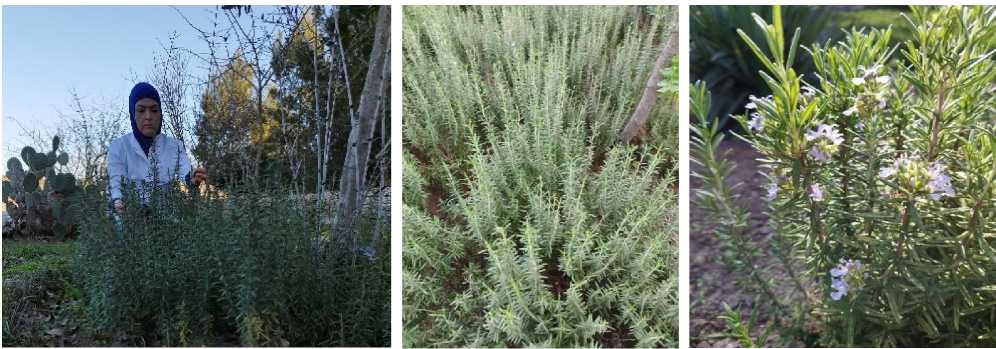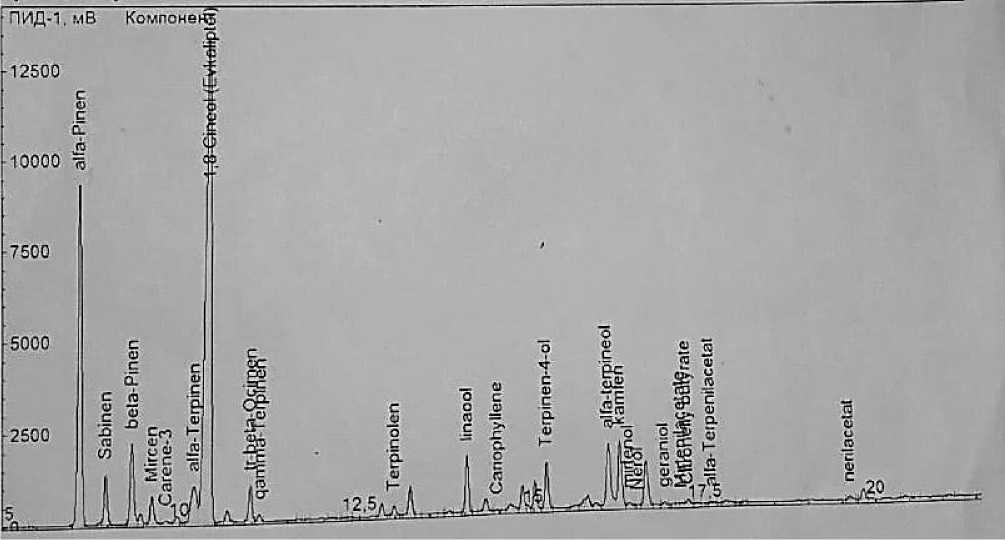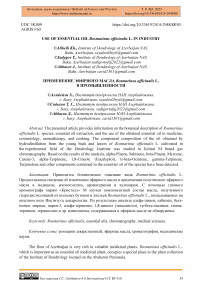Use of essential oil Rosmarinus officinalis L. in industry
Автор: Alibeili Khayala, Sadygov Tofig, Abbasov Javid
Журнал: Бюллетень науки и практики @bulletennauki
Рубрика: Биологические науки
Статья в выпуске: 3 т.9, 2023 года.
Бесплатный доступ
The presented article provides information on the botanical description of Rosmarinus officinalis L. species, essential oil extraction, and the use of the obtained essential oil in medicine, cosmetology, aromatherapy, and cooking. The component composition of the oil obtained by hydrodistillation from the young buds and leaves of Rosmarinus officinalis L. cultivated in the experimental field of the Dendrology Institute was studied in Kristal M brand gas chromatography. Based on the results of the analysis, alpha-Pinene, Sabinene, beta-Pinene, Myrcene, Carene-3, alpha-Terpinene, 1,8-Cineole (Eucalyptol), tr-beta-Ocimene, gamma-Terpinene, Terpinolene and other components contained in the essential oil of the species have been detected.
Rosmarinus officinalis, essential oils, chromatography, medical sciences
Короткий адрес: https://sciup.org/14126835
IDR: 14126835 | УДК: 58.009 | DOI: 10.33619/2414-2948/88/05
Текст краткого сообщения Use of essential oil Rosmarinus officinalis L. in industry
Бюллетень науки и практики / Bulletin of Science and Practice Т. 9. №3. 2023
UDC 58.009
The flora of Azerbaijan is very rich in valuable medicinal plants. Rosmarinus officinalis L., which is important as an essential oil medicinal plant, occupies a special place in the plant collection of the Institute of Dendrology located on the Absheron Peninsula.
Essential oils are used for a variety of purposes. Essential oils have a calming, antiseptic, antibacterial effect on the human body, cleanse the body of toxins, and have a positive effect on the immune system. Essential oils obtained from various organs of plants are used in cosmetology, medicine, and aromatherapy [2, 6].
Rosmarinus officinalis L. has a special place among the essential oils used in aromatherapy.
The main purpose of the research is to study the possibilities of using the essential oil obtained from Rosmarinus officinalis L. species.
Materials and methods
The component composition of the essential oil obtained by hydrodistillation from the young stems and leaves of the medicinal rosemary plant Rosmarinus officinalis L. was studied in Kristal M gas chromatography.
Rosmarinus officinalis L., a valuable medicinal plant, is rich in essential oils. The essential oil from this plant contains 25-30% pinene, 10-20% camphene, 10-30% cineole, 10-18% barneol, 6-17% camphor, and 6-10% sesquiterpenes [3]. In general, rosemary essential oil contains up to 20 different aromatic components [1, 2].
Results and discussion
Rosemary ( Rosmarinus officinalis L.) is a perennial evergreen shrub belonging to the Lamiaceae family. The homeland of this plant is considered to be the Mediterranean countries [3]. It has a strong root system and reaches a height of 1.5-2.0 m. The length of the leaves is 1.5-3.5 cm, the width is 0.2-0.4 cm, linear, sessile, simple structure. The upper surface of the leaves is dark green, and the lower side is covered with dense hairs, grayish green. The flowers are light purple and fragrant. The seeds are brown and small. It is propagated by division of the seed, pen and cocci [4, 5].

Figure 1. Rosmarinus officinalis L.
Rosemary ( Rosmarinus officinalis L.) is of great importance for health. Since ancient times, rosemary has been used as a medicinal plant in the treatment of many diseases. The ore prepared from the plant is used for headaches, colds, gastrointestinal diseases, and women's diseases [3]. This aromatic plant is also a diuretic. It helps to remove toxins from the body faster. The ore prepared from the rosemary plant calms the nerves, is used in heart neuroses and memory loss. The essential oil obtained from Rosmarinus officinalis L. species has a specific pleasant smell.
It has anti-stress and psychostimulating properties in aromatherapy. In medicine, it is used as an antibacterial, antifungal, pain reliever, anti-inflammatory, antiseptic, disinfectant. Antibacterial properties make rosemary essential oil suitable for use in face masks.
Table
THE RESULTS OF THE ANALYSIS OF THE OIL OBTAINED FROM THE LEAVES OF Rosmarinus officinalis L. IN KRISTALL 2000 M GAS-LIQUID CHROMATOGRAPHY
|
Component |
Percentage |
Component |
Percentage |
|
alfa-Pinen |
18,468 |
Terpinen-4-ol |
2,310 |
|
Sabinen |
2,357 |
alfa-terpineol |
4,093 |
|
beta-Pinen |
4,161 |
kamfen |
3,640 |
|
Mircen |
1,340 |
mirtenol |
0,159 |
|
Carene-3 |
0,140 |
Nerol |
0,062 |
|
alfa-Terpinen |
3,094 |
geraniol |
0,106 |
|
1,8-Cineol (Evkaliptol) |
41,357 |
Mirtenilacetate |
0,037 |
|
tr-beta-Ocimen |
1,638 |
Citronelly butyrate |
0,227 |
|
qamma-Terpinen |
0,289 |
alfa-Terpenilacetat |
0,077 |
|
Terpinolen |
0,486 |
nerilacetat |
0,181 |
|
linaool |
2,646 |
2-phenylethyl tiglate |
0,055 |
|
Cariophyllene |
0,042 |

Figure 2. Chromatographic analysis results
The essential oil obtained from medicinal rosemary is widely used both in medicine and for therapeutic purposes in aromatherapy. Rosemary oil is used both to prevent hair loss and to eliminate the problem of dandruff.
In cooking, rosemary plant is widely used to give special taste to food. Rosemary is rich in essential oils, used in perfumery and sometimes in the production of bread and confectionery [5].
Conclusion
As a result of our scientific research, it was determined that the Rosmarinus officinalis L. species develops normally when agrotechnical care is provided in Absheron conditions, and there is no need for special care in its cultivation. It is widely used in parks and gardens in Absheron.
Бюллетень науки и практики / Bulletin of Science and Practice Т. 9. №3. 2023
The essential oil obtained by hydrodistillation from the young stems and branches of Rosmarinus officinalis L., a valuable medicinal plant, is widely used in medicine, cosmetology, aromatherapy, and cooking.
Список литературы Use of essential oil Rosmarinus officinalis L. in industry
- Ахмедов А.-Д. И. Азербайджанская кулинария. Баку: Ишыг, 1986. 230 с.
- Флора Азербайджана. Баку: Изд-во Акад. наук АзССР, 1950-1961. 8 т.
- Гасымов М., Гадирова Г. Полезные растительные ресурсы Азербайджана. Баку: Маариф, 2009. 370 с.
- Мамедов Т., Исгендер Э., Талыбов Т. Редкие древесно-кустарниковые растения Азербайджана. Баку: Вяз, 2014. 380 с.
- Мамедов Т. С. Деревья и кустарники Апшерона. Баку: Наука и образование, 2010. 468 с.
- Деревья и кустарники СССР: дикорастущие, культивируемые и перспективные для интродукции. М.; Л.: Изд-во АН СССР, 1961. Т. 1.


